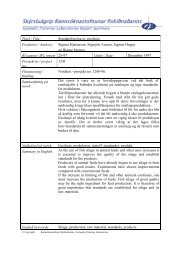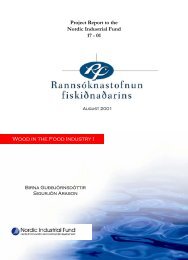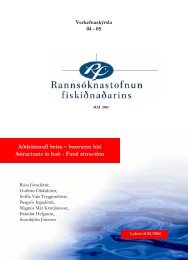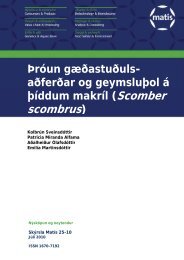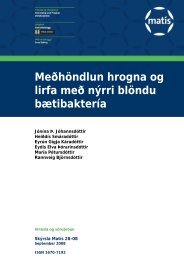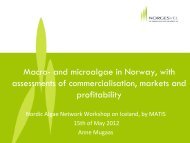Microbiology and Spoilage Trail in Nile Perch (Lates niloticus), Lake ...
Microbiology and Spoilage Trail in Nile Perch (Lates niloticus), Lake ...
Microbiology and Spoilage Trail in Nile Perch (Lates niloticus), Lake ...
You also want an ePaper? Increase the reach of your titles
YUMPU automatically turns print PDFs into web optimized ePapers that Google loves.
iii<br />
ABSTRACT<br />
The microbiological spoilage trail <strong>and</strong> storage time for iced whole <strong>Nile</strong> perch (<strong>Lates</strong><br />
<strong>niloticus</strong>) <strong>and</strong> chilled fillets were studied. Similarly, microorganisms of surface lake water,<br />
bottom sediments <strong>and</strong> whole <strong>Nile</strong> perch from fish<strong>in</strong>g grounds <strong>in</strong> Mwanza gulf was analysed<br />
<strong>in</strong> phase I. Phase II <strong>and</strong> III <strong>in</strong>cluded iced whole <strong>Nile</strong> perch, laboratory <strong>and</strong> four<br />
establishments’ chilled fillets, <strong>and</strong> all were stored at 0-3 o C dur<strong>in</strong>g shelf life study. Hence,<br />
the ma<strong>in</strong> goal of the study was to check prevalence of certa<strong>in</strong> human pathogens, ma<strong>in</strong><br />
spoilage organisms <strong>and</strong> establish shelf life (storage time) as well as effect of short <strong>and</strong> long<br />
storage of whole <strong>Nile</strong> perch <strong>in</strong> ice prior to process<strong>in</strong>g <strong>in</strong>to chilled fillets.<br />
The results showed variable bacteria counts for sediments <strong>and</strong> <strong>Nile</strong> perch guts while lake<br />
water results were approximately below method detection limit 0-20cfu/ml. It was<br />
concluded that human pathogens occasionally may be derived from fish<strong>in</strong>g grounds<br />
environments. The average keep<strong>in</strong>g quality (shelf life) <strong>in</strong> days for iced whole <strong>Nile</strong> perch,<br />
laboratory <strong>and</strong> establishments chilled fillets were 26-28; 17; 8-13 days respectively. Shelf<br />
life was short (8 days) for <strong>Nile</strong> perch fillets produced from long time (17 days) stored<br />
whole <strong>Nile</strong> perch <strong>in</strong> ice before process<strong>in</strong>g. In this work, the ma<strong>in</strong> spoilage organism’s<br />
composition <strong>in</strong> spoiled whole <strong>Nile</strong> perch <strong>and</strong> chilled fillets may <strong>in</strong>clude Shawenella<br />
putrefaciens, Vibrionaceae / Aeromonas, Pseudomonas, <strong>and</strong> Enterobacteriaceae. For both<br />
sensory/organoleptic (QIM score) assessment <strong>and</strong> microbiological methods were consistent<br />
while chemical method was not reliable dur<strong>in</strong>g early storages. Accord<strong>in</strong>gly it was suggested<br />
that the chemical (TVB-N) parameter is not reliable <strong>in</strong>dicator for freshness quality of iced<br />
whole <strong>Nile</strong> perch as well as chilled fillets.<br />
Keywords: <strong>Nile</strong> perch, chilled fillets, specific spoilage organisms (SSO); spoilage micro<br />
flora, chemical (TVB-N) <strong>and</strong> storage days.




